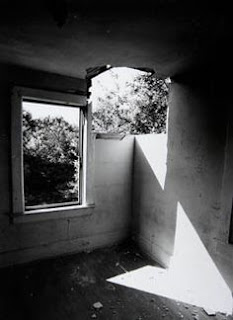 |
| Corner |
Since the corner is removed, you should be thinking “Well, the corner is gone”. Actually, the corner is more of a corner now than ever before. Like, this is a corner.
 |
| The Split |
The house is split. Because of that, the light is coming down through the split and is lighting the split. So it's a "self-lit" split.
 |
| Take Two |
The cut is so precise that, it is as if he was not cutting the house. He simply drew a line and then put bits of the house to hold that line in place.
 |
| Light |
Completion through removal. Abstraction of surfaces. Not-building, not-to rebuild, not-built space. Creating spatial complexity, reading new openings against the old surfaces. Light admitted into space or beyond surfaces that are cut. Breaking and entering. Transmitting the diagram into its structural context.
 |
| Warhol(e) |
Cutting a rectangle out of each wall that meets the corner. Making walls "windows" and you see the actual windows beyond the walls, something which you could not have seen before.






